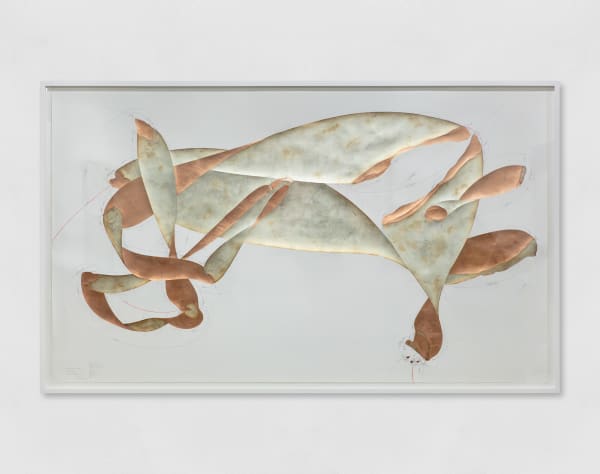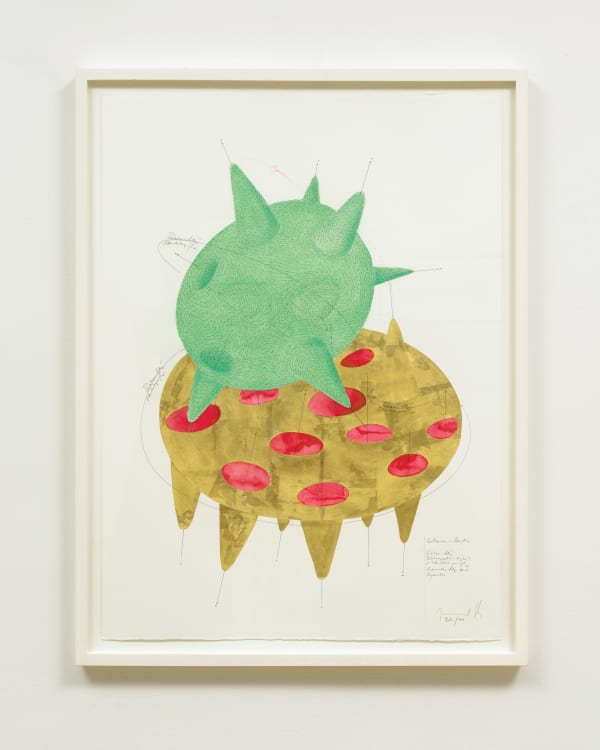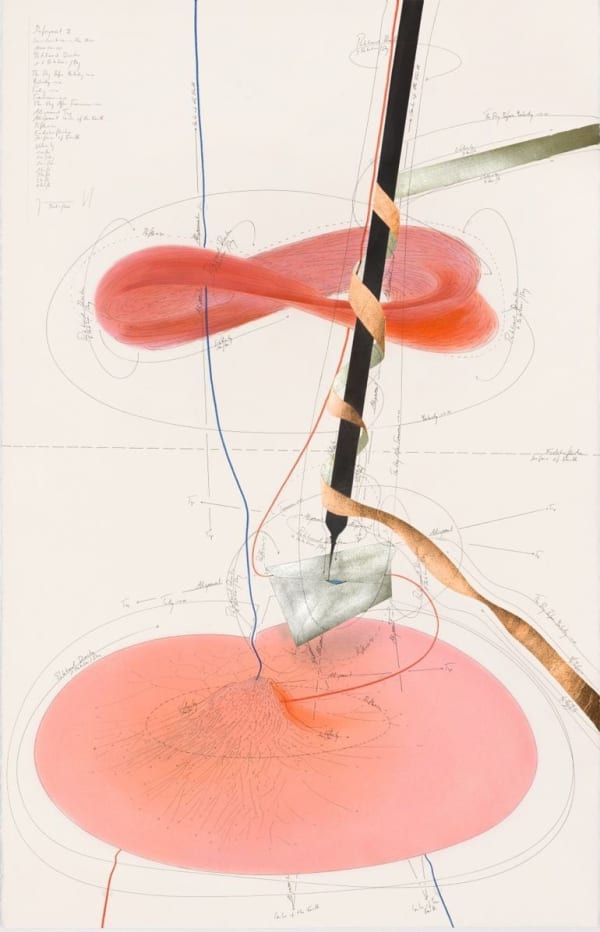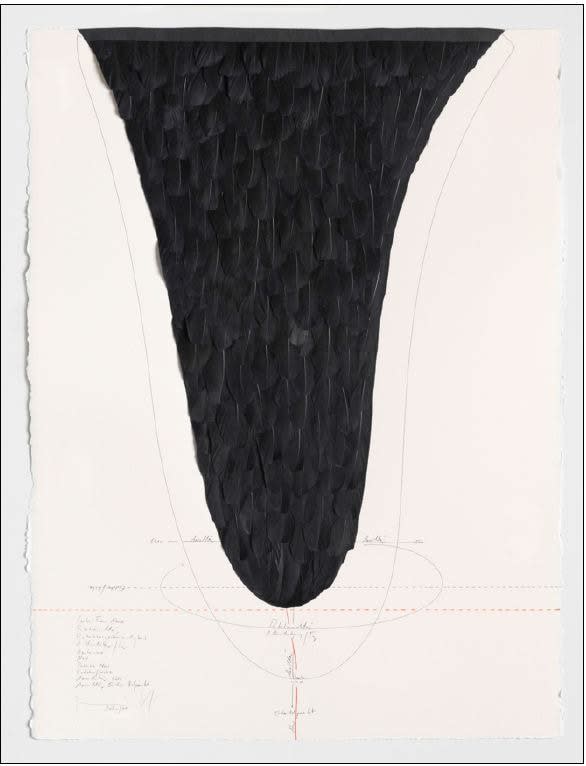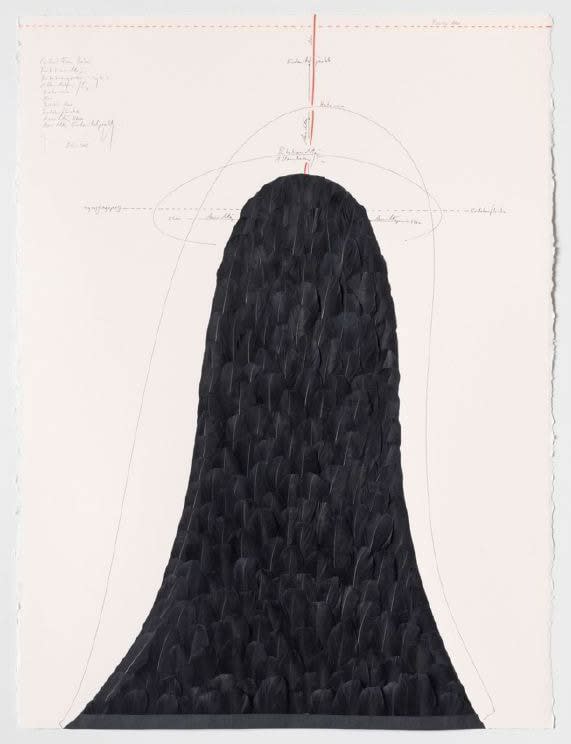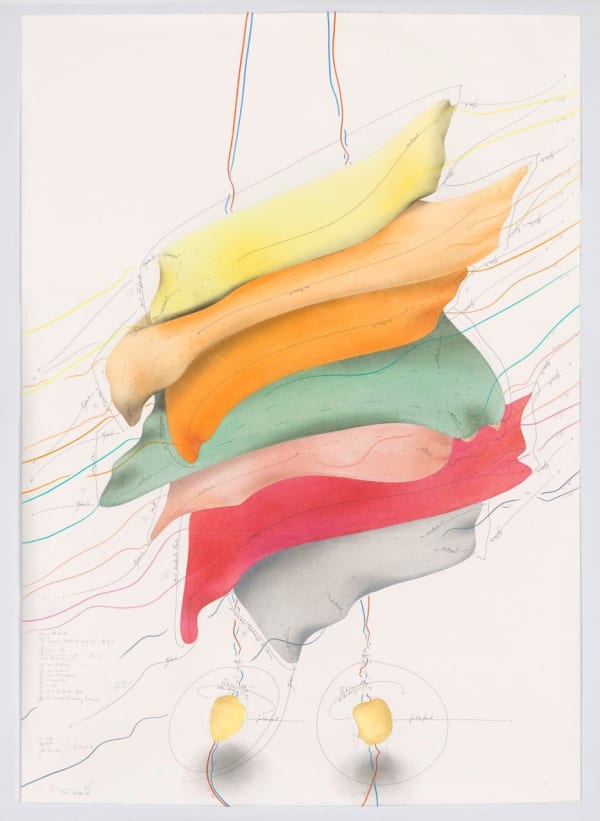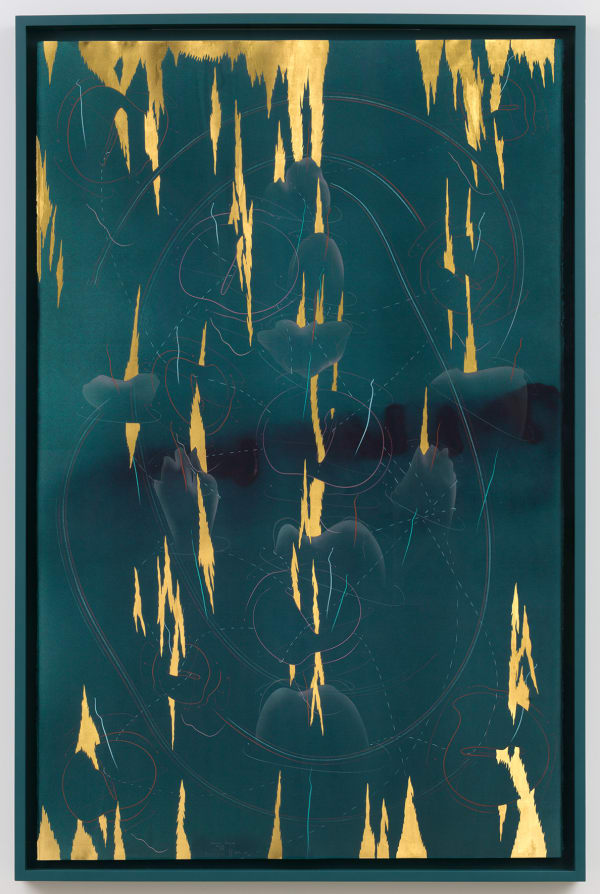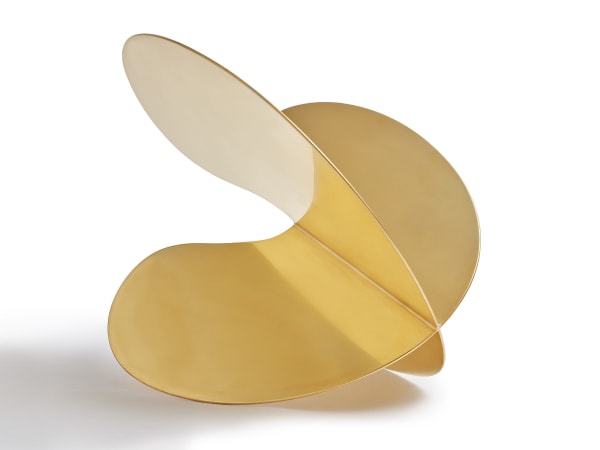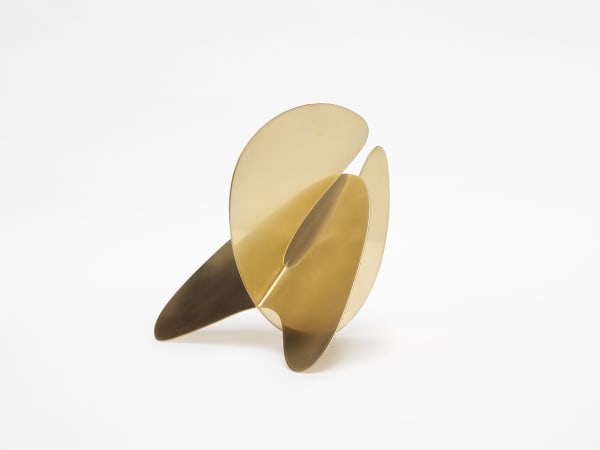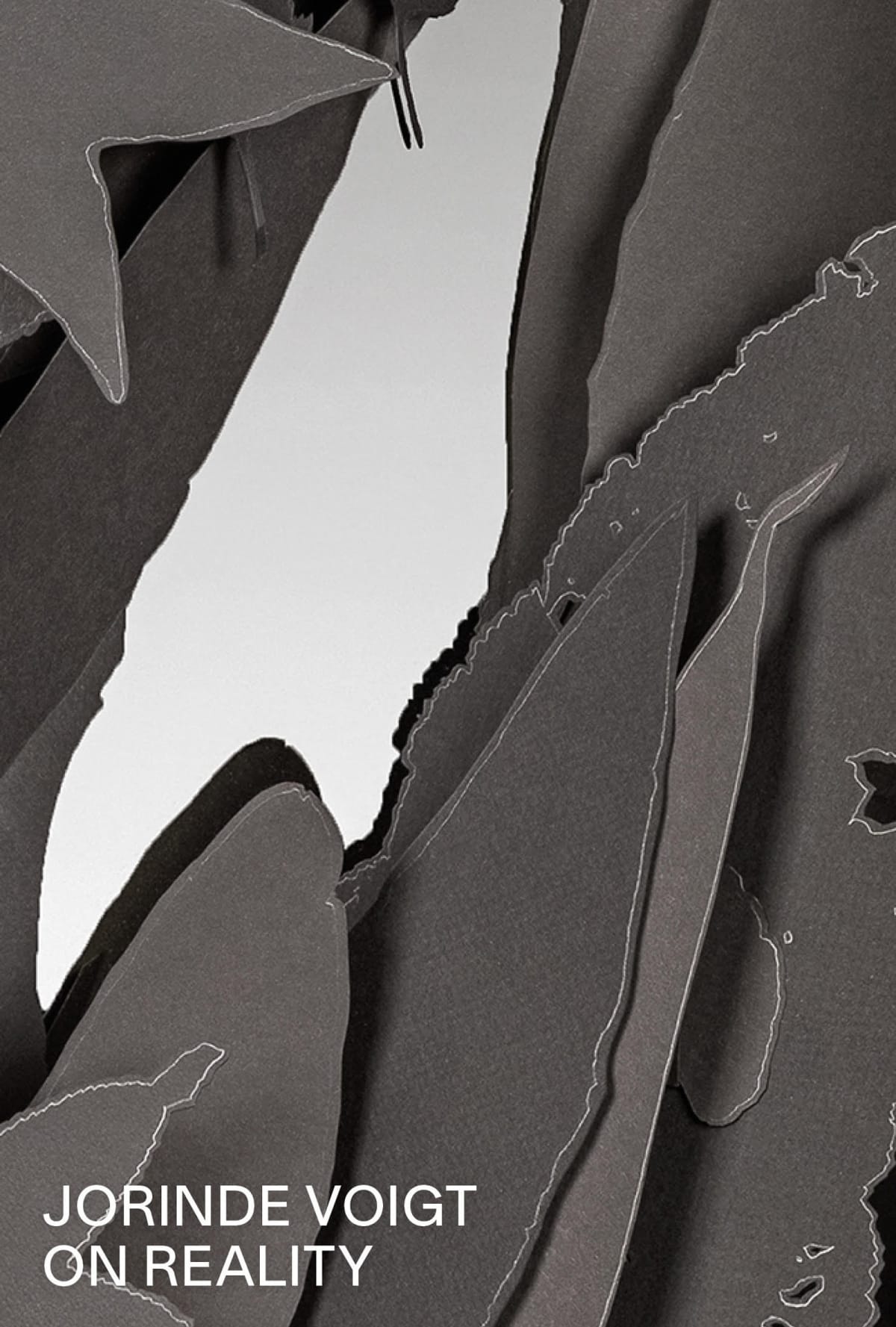JORINDE VOIGT: The Match
-
Overview
David Nolan Gallery is delighted to present Jorinde Voigt: The Match, the artist’s eighth solo show with the gallery, on view from February 17 through March 25, 2023. The exhibition will include Voigt’s newest project, consisting of highly reflective interlocking sculptures titled Dyads. Made between 2022 and 2023, these gold-plated stainless steel floor sculptures have never before been exhibited in America. Four of these sculptures will be on view in The Match alongside works on paper from the last decade, demonstrating Voigt’s ever-evolving investigations on space, time, and materials. While encompassing 10 years of the artist’s conceptual practice, The Match will stage two-dimensional works on paper with three-dimensional paper objects to interact in the space with metal sculptures, suggesting multiple readings of perception and movement, and showing deep connections among all the works. The rich gold surfaces of the large, freestanding sculptures reflect light and movement as we rotate around them and witness the endless possible permutations of the forms. The title, Dyad, refers to a theme that has been a constant in Voigt’s work—the duality between humans in philosophy, physics, and nature.
Since her earliest years, through the medium of drawing, Voigt has devised a complex and highly developed system of articulating immaterial phenomena as visually engaging compositions. Suggesting the appearance of scientific diagrams or musical scores, these seemingly abstract arrangements encompass a very precise range of references.
Voigt’s intuitive and expressive works evolve from rigorous meditative and observational processes that seek to capture the complexity and velocity of her environment through abstract configurations and systems that depict the intersection of one’s inner world, emotions, and memory with external conditions. Constantly engaging questions of perception, sensation, and presence, the artist has progressively expanded her expression beyond the medium of drawing to experiment with painterly elements, collage, design, and music.
While the artist’s earlier work dealt with music, philosophy, and physics, it subsequently progressed to explore new realities and forms that repeat themselves in pairs and clusters, as in nature. The large drawings on view from Love as Passion: The Codification of Intimacy (2014) are visually sumptuous and reflect the artist’s newly discovered fascination with the reflection created by gold, copper, and silver leaf, which she augmented with intensely colored pastel and watercolor elements. For that body of work, Voigt took inspiration from the eponymous 1982 book by German sociologist Niklas Luhmann, which analyzed the evolution of love in Western Europe from the 17th century through modern societies. In keeping with her practice, she identified keywords and passages that would trigger intuitive associations, and she transposed the essential concepts into visual images. With scientific care, the artist handwrote annotations that served as references to particular chapters or passages in the book. Across the sheet, freehand ink lines connecting key elements constructed a matrix that defined Voigt’s spatial and temporal parameters.
The Immersion and Immersive Integral drawings (2018) deal with how we perceive rather than exactly what we perceive. Voigt’s inquiry into the nature of perception seeks to develop the appropriate forms to understand the inner constitution of archetypal images, that which is behind what we see, and how such images might be experienced or shared collectively. The doughnut shape (torus) appears throughout the works in this series, a geometric form explored by French psychoanalyst Jacques Lacan to illustrate his notion of “extimacy” (extimité), a neologism that combined the terms exterior (exterieur) and intimacy (intimité). Voigt’s landscapes of de-centered, ex-centric forms depict the unconscious as an inter-subjective rather than purely interior structure—something that although we may be immersed within will always remain outside of us, as something other, as Lacan writes in The Seminar: Book VII (1992), “something strange to me, although it is at the heart of me.”
The luscious colors of Potential (2020) and The Sum and Me (2022) draw us into a world of constant change of natural phenomena. Voigt’s process began by hand dying each sheet of paper with a hue that corresponded to specific stimuli or emotion—in this case a midnight blue that has real-life associations (marine or cosmological phenomena, etc.)—to which Voigt’s meticulous notations, gold leaf applications, and gestural markings add a layer of visual coding that conveys an emotional meaning and lulls the viewer into a kind of dream state, at once familiar and otherworldly.
In Ludwig van Beethoven - Opus 33, Nr. 6 (2020), the artist does not strive to illustrate or interpret the music; rather, she is more concerned with researching perception and “developing a way of writing that extracts the emotional spectrum inscribed in Beethoven’s scores”—in other words, to survey the invisible. This investigation progresses with Study of Reality (2021), Particella (2021), and Fugue (2021), where Voigt combines drawing and collage, mounting a three-dimensional collage onto mirror glass. While smaller in scale than most of her work, these works play with the viewer's perception and the changing effects of light by creating the illusion of infinite space across the depth of superimposed layers of paper and the reflections produced by the mirror in the background.
Rhythm (2022) creates lines in three dimensions by slicing, cutting, repositioning, and layering colored paper and existing drawn lines into new configurations. Voigt’s experimentation evolves towards sculptural compositions, textured and graphic at times, or delicately shaped, such as the metal Dyads, where co-existing rhythms come together to organic units and the materials themselves yield questions about limitations, borders, and resilience, which can be expanded in scope to think more broadly about the interlocking rhythms of our world.
Jorinde Voigt (b. 1977, Frankfurt am Main) is a leading conceptual artist based in Berlin. She studied with Katharina Sieverding at Universität de Künste, Berlin, graduating with her Master of Fine Arts in 2004. From 2014 to 2019, she taught at Akademie der Bildenden Künste in Munich, and today she is a Professor of Conceptual Drawing and Painting at University of Fine Arts Hamburg. She has participated in biennials worldwide, most notably the 54th International Art Exhibition – La Biennale di Venezia (2011); Manifesta 11, Zurich (2016); Biennale de Lyon (2017); and Sharjah Biennial (2017). Recent solo exhibitions of her work have been presented by Kunsthistorisches Museum Wien (2020); BOZAR, Centre for Fine Arts, Brussels (2020); The Menil Collection, Houston (2019); Horst Janssen-Museum, Oldenburg (2019); Kunsthalle Nürnberg (2017); Hamburger Bahnhof Museum für Gegenwart, Berlin (2016); Kunsthalle Krems (2015); Museo d’Arte Contemporanea, Rome (2014); the Langen Foundation, Neuss (2013); Gemeentemuseum, Den Haag (2010); as well as Moody Center for the Arts, Rice University, Houston (2022). Voigt’s work is included in the permanent collections of notable institutions worldwide, including the Art Institute of Chicago; Centre Pompidou, Paris; Kunsthaus Zürich; The Morgan Library and Museum, New York; Museum of Modern Art, New York; Pinakothek der Moderne, Munich; Bundeskunstsammlung, Bonn; Staatliche Museen zu Berlin – Kupferstichkabinett, Berlin; Kunsthalle Praha Collection, Prague; Istanbul Museum of Modern Art; Museum of Contemporary Art, Oslo; and Kunstmuseum Stuttgart, among others.
-
Installation Views
-
-

-

-

-
 Jorinde VoigtLuhmann-Studie, 2014ink, pencil, chalk, ink, and gold leaf on paper29 7/8 x 22 in (76 x 56 cm)
Jorinde VoigtLuhmann-Studie, 2014ink, pencil, chalk, ink, and gold leaf on paper29 7/8 x 22 in (76 x 56 cm) -
 Jorinde VoigtDefragment II - Considerations in the Now, 2016ink, copper leaf, gold leaf, oil pastel, pastel, pencil on paper40 1/4 x 26 in (102 x 66 cm)
Jorinde VoigtDefragment II - Considerations in the Now, 2016ink, copper leaf, gold leaf, oil pastel, pastel, pencil on paper40 1/4 x 26 in (102 x 66 cm)
framed: 43 3/8 x 29 5/8 x 1 3/4 in (110.1 x 75.3 x 4.5 cm) -
 Jorinde VoigtSynchronicity (1), 2015ink, feathers, chalk, pencil on board24 3/4 x 35 7/8 in (63 x 91 cm)
Jorinde VoigtSynchronicity (1), 2015ink, feathers, chalk, pencil on board24 3/4 x 35 7/8 in (63 x 91 cm)
framed: 28 1/8 x 39 1/4 x 2 3/4in (71.4 x 100 x 7 cm) -
 Jorinde VoigtCentral From Above, 2015ink, feathers, oil pastels, pencil on paper30 1/2 x 22 5/8 in (77.5 x 57.5 cm)
Jorinde VoigtCentral From Above, 2015ink, feathers, oil pastels, pencil on paper30 1/2 x 22 5/8 in (77.5 x 57.5 cm)
framed: 34 x 26 1/2 in x 2 3/4 in (86.4 x 67.3 x 7 cm) -
 Jorinde VoigtCentral From Below, 2015ink, feathers, oil pastels, pencil on paper30 1/2 x 22 5/8 in (77.5 x 57.5 cm)
Jorinde VoigtCentral From Below, 2015ink, feathers, oil pastels, pencil on paper30 1/2 x 22 5/8 in (77.5 x 57.5 cm)
framed: 34 x 26 1/2 x 2 3/4 in (86.4 x 67.3 x 7 cm) -
 Jorinde VoigtThe Farewell / A New Kind of Joy - Study 1 (Song of the Earth), 2016ink, gold leaf, oil pastel, pastel, pencil on paper55 1/2 x 39 3/8 in (141 x 100 cm)
Jorinde VoigtThe Farewell / A New Kind of Joy - Study 1 (Song of the Earth), 2016ink, gold leaf, oil pastel, pastel, pencil on paper55 1/2 x 39 3/8 in (141 x 100 cm)
framed: 59 7/8 x 44 x 2 in (152.1 x 111.8 x 5 cm) -
 Jorinde VoigtHills XVII, 2017ink, gold leaf, pastel, oil pastel, and graphite on paper40 3/16 x 26 in (102 x 66 cm)
Jorinde VoigtHills XVII, 2017ink, gold leaf, pastel, oil pastel, and graphite on paper40 3/16 x 26 in (102 x 66 cm)
framed: 43 x 28 7/8 x 3 1/8 in (109.2 x 73.3 x 7.9 cm) -

-
 Jorinde VoigtImmersive Integral Zenith XVII, 2018India ink, gold leaf, pastel, oil pastel, and graphite on paper in artist's frame86 1/4 x 55 1/2 in (219 x 141 cm)
Jorinde VoigtImmersive Integral Zenith XVII, 2018India ink, gold leaf, pastel, oil pastel, and graphite on paper in artist's frame86 1/4 x 55 1/2 in (219 x 141 cm)
framed: 92 x 60 x 4 in (233.7 x 152.4 x 10.2 cm) -

-

-

-

-
 Jorinde VoigtBetrachtung/ Contemplation 12, 2020gold-plated brass; unique68 7/8 x 21 3/4 x 21 5/8 in (175 x 55.3 x 55 cm)
Jorinde VoigtBetrachtung/ Contemplation 12, 2020gold-plated brass; unique68 7/8 x 21 3/4 x 21 5/8 in (175 x 55.3 x 55 cm) -
 Jorinde VoigtBetrachtung/ Contemplation 25, 2020gold-plated brass56 1/4 x 13 3/8 x 13 3/8 in (143 x 34 x 34 cm)
Jorinde VoigtBetrachtung/ Contemplation 25, 2020gold-plated brass56 1/4 x 13 3/8 x 13 3/8 in (143 x 34 x 34 cm) -
 Jorinde VoigtLudwig van Beethoven - Opus 33, Nr. 6, 2020ink, gold leaf, pastel, oil pastel, and graphite on paper31 1/2 x 70 7/8 in (80 x 180 cm)
Jorinde VoigtLudwig van Beethoven - Opus 33, Nr. 6, 2020ink, gold leaf, pastel, oil pastel, and graphite on paper31 1/2 x 70 7/8 in (80 x 180 cm)
framed: 35 7/8 x 75 1/4 x 2 5/8 in (91.1 x 191.1 x 6.7 cm) -
 Jorinde VoigtStudy of Reality X, 2021ink and graphite on paper, collage mounted on mirror glass13 3/8 x 9 7/8 x 2 3/4 in (34 x 25 x 7 cm)
Jorinde VoigtStudy of Reality X, 2021ink and graphite on paper, collage mounted on mirror glass13 3/8 x 9 7/8 x 2 3/4 in (34 x 25 x 7 cm) -
 Jorinde VoigtStudy of Reality XII, 2021ink and graphite on paper, collage mounted on mirror glass13 3/8 x 9 7/8 x 2 3/4 in (34 x 25 x 7 cm)
Jorinde VoigtStudy of Reality XII, 2021ink and graphite on paper, collage mounted on mirror glass13 3/8 x 9 7/8 x 2 3/4 in (34 x 25 x 7 cm) -

-

-
 Jorinde VoigtParticella V (Aegean, the Evening Before), 2021oil chalks, ink and graphite on paper, collage mounted on mirror glassframed: 22 1/2 x 18 7/8 x 2 3/4 in (57 x 48 x 7 cm)
Jorinde VoigtParticella V (Aegean, the Evening Before), 2021oil chalks, ink and graphite on paper, collage mounted on mirror glassframed: 22 1/2 x 18 7/8 x 2 3/4 in (57 x 48 x 7 cm) -

-

-

-
 Jorinde VoigtDyade 14, 2022gilded stainless steel, framed32 1/2 x 54 1/8 x 57 7/8 in (82.5 x 137.5 x 147 cm)
Jorinde VoigtDyade 14, 2022gilded stainless steel, framed32 1/2 x 54 1/8 x 57 7/8 in (82.5 x 137.5 x 147 cm) -
 Jorinde VoigtDyade 13, 2022gilded stainless steel30 1/2 x 47 1/4 x 40 3/8 in (77.5 x 120 x 102.5 cm)
Jorinde VoigtDyade 13, 2022gilded stainless steel30 1/2 x 47 1/4 x 40 3/8 in (77.5 x 120 x 102.5 cm) -
 Jorinde VoigtDyade 10, 2022gilded stainless steel18 3/4 x 19 1/4 x 17 7/8 in (47.5 x 49 x 45.5 cm)
Jorinde VoigtDyade 10, 2022gilded stainless steel18 3/4 x 19 1/4 x 17 7/8 in (47.5 x 49 x 45.5 cm) -
 Jorinde VoigtDyade 09, 2022gilded stainless steel, framed20 1/8 x 14 3/4 x 19 1/4 in (51 x 37.5 x 49 cm)
Jorinde VoigtDyade 09, 2022gilded stainless steel, framed20 1/8 x 14 3/4 x 19 1/4 in (51 x 37.5 x 49 cm) -

-
 Jorinde VoigtTriad 2, 2023alder wood8 5/8 x 23 x 16 7/8 in (22 x 58.5 x 42.8 cm)
Jorinde VoigtTriad 2, 2023alder wood8 5/8 x 23 x 16 7/8 in (22 x 58.5 x 42.8 cm)
-
-
PRESS
-
Publications
-
Artist



